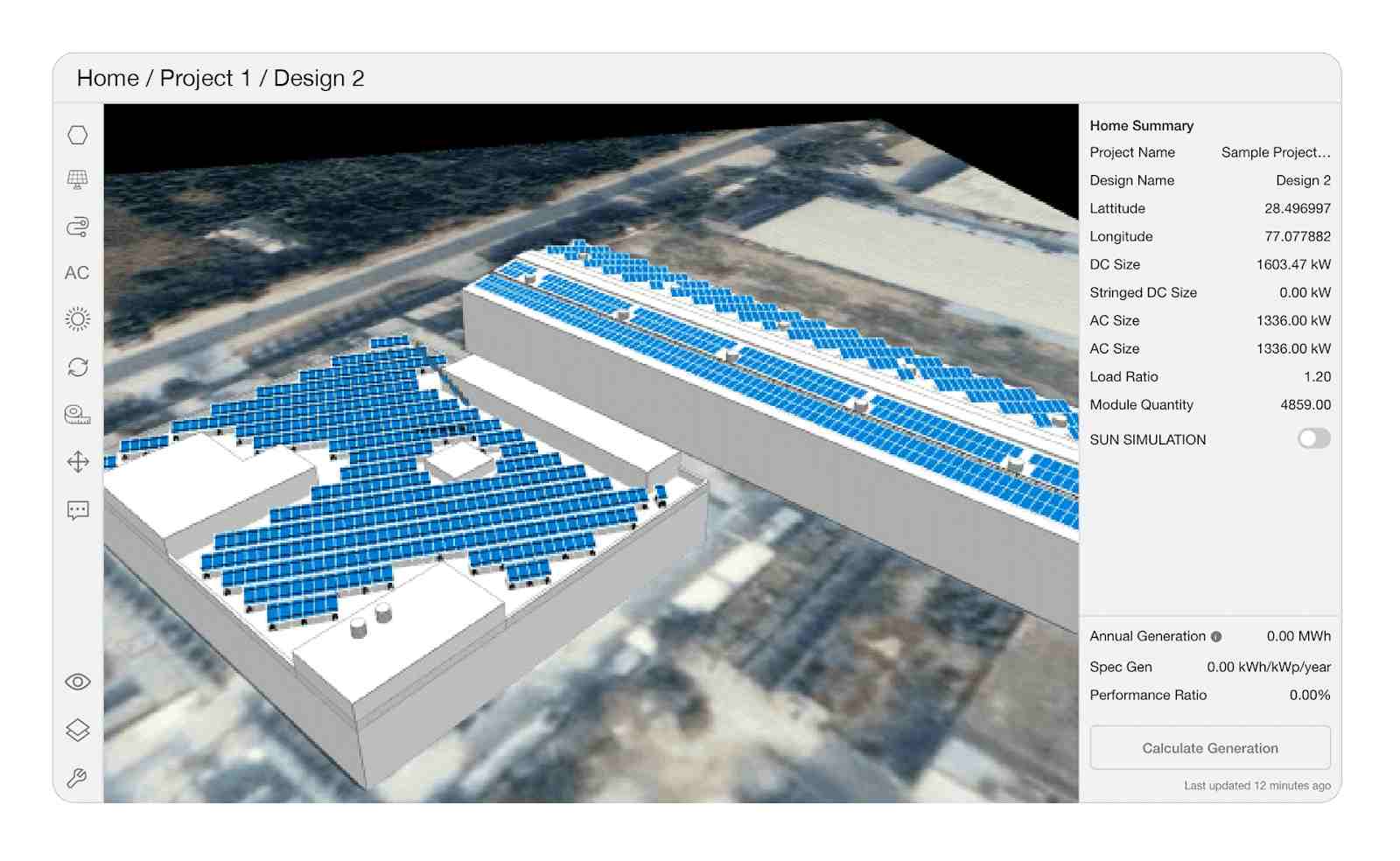
The solar industry is expanding quickly in 2025 and project complexity continues to rise. Installers are managing more rooftops in more shapes and terrains and new technologies such as bifacial modules and tracking structures need careful planning.
Because of this shift, 3D design software has moved from a nice extra to a serious necessity. It has become one of the most powerful ways to improve design accuracy and project success.
3D solar design software uses detailed modelling of roof geometry and shading patterns to build realistic solar layouts. It increases accuracy and reduces revision cycles. It shortens project time and supports teams in delivering more projects without running into surprises on site.
Let’s learn more.
3D solar design software is a digital environment that recreates the real-world conditions of a solar project site. It is different from 2D drawings or basic CAD layouts because those produce a flat design that cannot represent true roof shape or real shade behaviour.
Most roofs are not uniform surfaces and many have varying pitches and structural details. There are skylights, parapet walls, pipes, and vents. There are trees or nearby structures that change shadow movement through the day. A flat 2D layout often misses important issues until construction begins. At that stage, correction costs more time and more money.
3D design solves that problem by producing a lifelike digital version of the site. It rebuilds the roof surface and obstruction details. It shows how sunlight moves hour by hour. It predicts energy performance with greater reliability. It also converts the model into a proposal that customers can clearly understand.
Energyscape Renewables explains that 3D modelling helps engineers work with detailed representations that mirror real site behaviour. That level of clarity lets both designers and customers move forward with confidence.
Visualising a simple comparison makes the difference clear. A 2D rooftop drawing looks clean and empty, but it hides a vent that casts shade. A 3D model includes the vent and shows an exact shadow pattern which changes the layout before installation begins. Accuracy at this early stage prevents costly redesign later.
The shift happening in 2025 is based on scale and demand. More homeowners are switching to solar and commercial and industrial adoption is also expanding. Project volume is rising and system types are diversifying. At the same time remote assessments are becoming standard and customers expect quick answers along with strong visual communication.
A report from Spotio, “10 Best Solar Design Software Tools in 2025”, highlights how important remote surveying and 3D modelling have become. EPC teams want to complete more work with fewer site visits and with fewer errors.
Many are also dealing with thinner margins and tighter schedules. Any mistake in shading assumptions or panel placement can reduce project profitability. 3D solar design software protects those margins with realistic planning based on actual data rather than assumptions.
Customers also expect visual proposals. They want to see how panels fit on their roof and how much energy the system can generate. A realistic three-dimensional preview creates trust instantly and increases confidence during purchasing. Many companies who adopt visual proposals report higher project acceptance rates.
Technology growth also plays a major role. The industry progressed from paper-based layouts to 2D CAD and later to 3D modelling. Now it is entering a phase where artificial intelligence assists the design process. AI-powered tools detect roof edges, place panels automatically, and calculate shading in seconds. That type of automation marks a major shift in efficiency.
This transition explains why 2025 is an important moment. Companies that adopt these tools now gain speed and accuracy while those who continue with 2D methods face a higher risk and slower output.

Real-world geometry and obstruction modelling make a major difference in design accuracy. A realistic 3D environment captures every roof element. Designers understand exactly where obstacles exist before construction starts. That detail prevents on-site layout adjustments and unexpected rework.
SiteCapture highlights that 3D modelling is now a core requirement in solar design because accuracy begins with a correct structure.
Advanced shading and irradiance simulation are also essential. Shading can reduce generation sharply and even a small shadow can affect performance. Modern 3D solar design software simulates sunlight conditions throughout the year using data such as LiDAR scans or high-resolution mapping.
It examines shade movement hour by hour and reveals ideal placement for the highest yield. This ensures better customer satisfaction and more reliable performance predictions.
Automated layout and optimisation remove repetitive manual effort. The platform arranges modules in the most efficient configuration and creates suitable stringing and orientation. Designers save time because the software performs tasks that once took hours. It lowers errors and speeds up design delivery.
The final important capability is proposal and output generation. Once the design is ready, teams need to present results clearly. Professional output includes system visuals, expected yield, equipment lists and loss analysis. When sales teams show accurate 3D visuals and real performance estimates, customers feel informed and ready to move forward.
All these capabilities together raise the standard of solar projects. They minimise field corrections and create predictable and profitable workflows.
Accuracy makes a measurable financial impact. Better design decisions reduce site revisions and change orders. Teams spend less time correcting mistakes and more time building projects. Avoiding redesign also cuts material waste and labour hours.
Faster design speed allows each designer to handle more projects at once. Companies that adopt 3D solar design software often see significant improvement in throughput because design tasks become easier and automation handles routine work. A design that once took half a day can be finished in minutes.
Better proposals improve customer trust. People understand what they are buying and feel confident about expected returns. Clear visual presentation often leads to higher proposal acceptance rates. Many installers share that after using detailed 3D tools they experience shorter sales cycles and improved close ratios.
An article from Energyscape Renewables explains that accurate and realistic modelling leads to faster project completion and better efficiency. These gains are why most scaling EPC companies are embracing 3D tools.
.png)
Successful adoption begins with reviewing the current workflow. Teams need to understand what slows them down and where errors appear frequently. They study how long the design takes and how many revisions are needed before installation.
The next stage is selecting a platform with strong modelling accuracy and dependable shading analysis. Proposal output matters too because design is most effective when sales and operations stay connected.
Running a pilot on a few existing projects helps compare results with the previous method. When teams measure time savings and accuracy improvement, the value becomes clear.
Training also matters for success. Designers adapt quickly when they work with new modelling tools. Sales teams learn to use realistic visuals during presentations and operations teams learn to follow updated drawings. Everyone benefits from a shared process.
Performance tracking turns improvement into growth. Measuring project output per designer, change order reduction, and proposal close rates helps companies scale confidently.
.gif)
Choosing the right tool should focus on measurable value. A strong platform offers accurate roof modelling, realistic shading simulation, automated layout, reliable energy production data, and a simple workflow. Proposal generation strengthens the process since it avoids switching between disconnected systems.
The best selection also depends on business type. Residential installers benefit from speed and remote assessment. Commercial projects benefit from advanced modelling and detailed coordination.
Large teams need deeper integration with existing workflow tools and CRM systems. Budget and training support also influence final decisions because software should fit long-term needs, not short-term cost alone.
A clear understanding of goals and workflow challenges helps EPC teams select a tool that delivers real growth.
Does 3D modelling add significant cost compared to 2D?
No. It improves accuracy so it usually reduces cost overall. Savings from fewer revisions and less field work outweigh small software subscription expenses.
Are 3D design tools useful for small rooftop jobs?
Yes. Even small roofs have obstructions like vents or pipes. A single shading mistake can reduce energy output. 3D tools prevent such problems.
How much accuracy improvement can I expect?
Many installers report significant improvement. Designs become consistent with real measurements. Energy yield predictions become more trustworthy.
Can 3D design tools integrate with proposal and CRM systems?
Yes. Many platforms connect proposals and sales workflows. This creates a single connected system from design to closing.
.png)
3D solar design software is now an essential tool for EPC companies that want accuracy, speed, and stronger results. It helps reduce design errors and construction surprises. It accelerates projects and improves profit margins.
It builds trust through realistic visuals and clear performance data. The solar industry is growing too fast for older methods that depend on guesswork. Precision and automation are the new standard for success.
With the 3D design module inside ARKA 360, teams can model real-world roof geometry and examine shading with dependable simulation. They can optimise layout and present accurate proposals in the same environment.
This improves design speed and proposal success and creates a smoother workflow from planning to installation. Ask for a demo to explore how ARKA 360 supports your growth with advanced solar design software.













